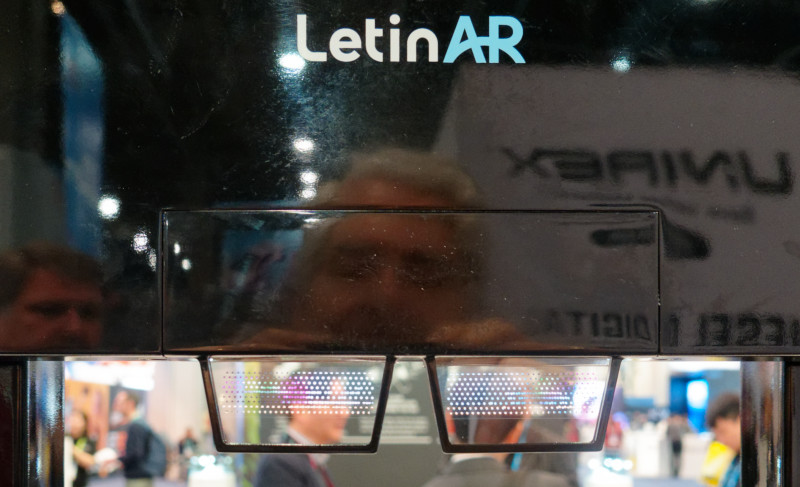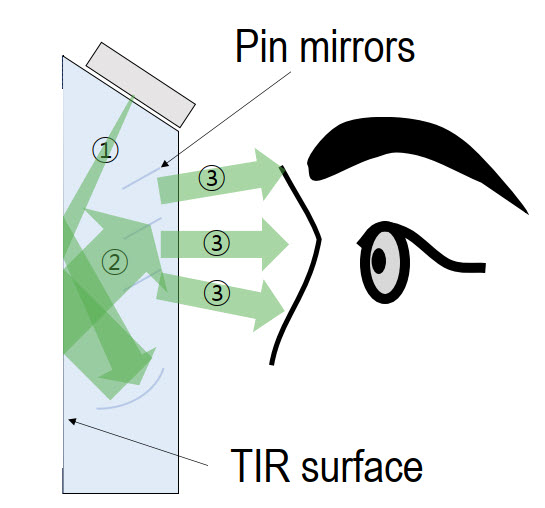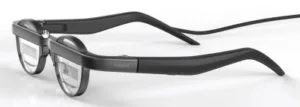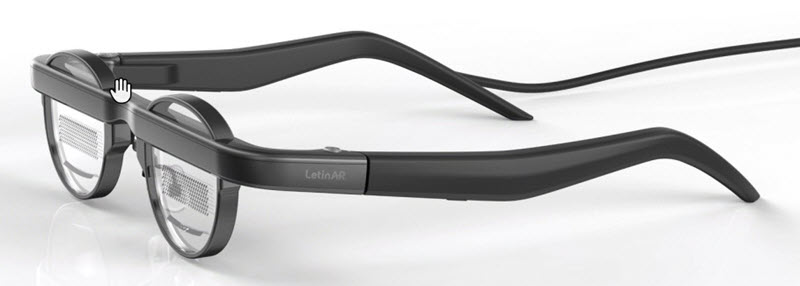We’ve been reporting on Korean AR optics company LetinAR since we met up with them in the Sands Eureka Park at CES 2018 and immediately the appeal of the technology was apparent to me.
I met them again at Mobile World a couple of months later and the late and missed Matt Brennesholz wrote a very interesting deeper dive on the firm’s technology in June 2018.LetinAR Discusses Unique Pin Mirror AR HMD Design. Since then, we’ve been following developments and at this year’s SID/DSCC Business Conference, the firm presented on its latest technology developments.
First some background, as Arthur would say. LetinAR’s key technology is the use of pin mirrors to reflect images from a display into the eye. The pin mirrors are so close to the eye that the eye can’t focus on them but, because they are mirrors, they do not suffer from the chromatic abberations that are seen in lenses. A downside is that the mirrors are visible from outside the glasses. However, the technology is based on injection moulding of the lenses so, in bulk, they can be light and relatively cheap.
 I took this photo at CES in 2020. When your eyes are close to the glasses, the dots are not visible. Image:Meko
I took this photo at CES in 2020. When your eyes are close to the glasses, the dots are not visible. Image:Meko
Many Developments
The company has made key developments since we first met. One of the key developments has been the move to use plastics rather than glass for the lenses. That makes a big difference to the weight of the glasses. Although tooling for injection moulding can be expensive, once you have a tool, the cost of plastic can be much lower than glass devices, although the refractive index of the material is around 1.5 to 1.6 rather than the 1.9 to 2.0 of high refractive index glass. The use of regular plastics as used in normal spectacles means that standard technologies for treatment and processing (e.g. anti-reflection surfaces) can be applied as well as the regular prescription corrections. The lenses can be quite big – the firm can make them up over 60 x 40mm.
Just to give a sense of the weight issue, the firm told us in an interview that the weight of a lens is less than 5 grams per eye.
 The PinTILT technology means just a couple of TIR reflections
The PinTILT technology means just a couple of TIR reflections
The other big development is in what the firm calls PinTILT technology. This is a technology to allow images to be directed from the display via a couple of TIR surface bounces and an internal mirror to the pin mirrors. This means that the light can be efficiently sent to the eye and the firm says that its glasses can be around 10% efficient typically (and up to 15%). That’s impressive – when we talk to people looking at waveguides, the efficiency is very dramatically less than that. That means that with waveguides, you need a lot more starting luminance to get enough nits to the eye. The firm told us that while it has competitors that talk of several watts per eye (!) of power consumption, it’s system uses less than 1W.
Lenses can be monocular or binocular and resolutions up to 1080p can be supported using microOLED displays in the glasses. The firm has developed an evaluation kit. LetinAR told us that it has found that 1080P resolution is plenty for the kind of B2B applications and that’s fine for the kind of 0.5″ MicroOLEDs, the maximum size currently used. The evaluation kit has 0.23″ microOLEDs with a 22° FOV.
The system has a reasonable eyebox (that is to say the area where the pupil can be to still have a usable image and which varies significantly from individual to individual) of around 10mm horizontally.
One of the disadvantages of the glasses from a consumer perspective is that the pin mirrors in the current design are very visible to people that are not the wearer. The firm pointed out that pin mirrors are not the only optical elements that it can use and that other shapes could be much less visible, but deliver similar performance. Different elements could also be used for other reasons, for example to extend the eyebox. Realistically, it doesn’t expect to see its technology in consumer glasses until later, although it is in discussions with a number of big names.
Since we first met, LetinAR has really developed. From a small start-up, it now has 50 staff including 39 in R&D and from key Korean technology firms including Samsung, LG and Hyundai. It has been through two series of funding (+ seed funding) – the second in November 2021 and it now has its own production facilities for the optical elements. It has moved from Seoul to ‘near-Seoul’ and is establishing a facility in the US, although that has proved particularly tricky because of Covid. It is building up its supply chain and hopes to keep manufacturing itself in the future. (BR)
This article was independently produced by Display Daily, but was moved outside the paywall by LetinAR. It does not count as one of your free articles if you are not a paid subscriber.


